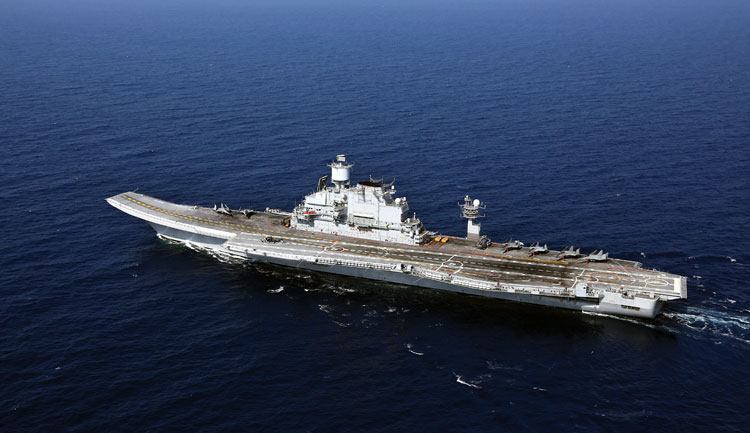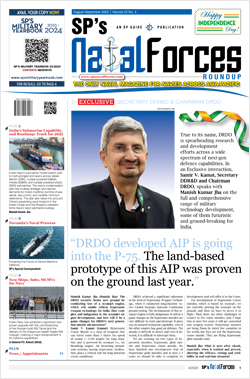INDIAN ARMED FORCES CHIEFS ON OUR RELENTLESS AND FOCUSED PUBLISHING EFFORTS

The insightful articles, inspiring narrations and analytical perspectives presented by the Editorial Team, establish an alluring connect with the reader. My compliments and best wishes to SP Guide Publications.

"Over the past 60 years, the growth of SP Guide Publications has mirrored the rising stature of Indian Navy. Its well-researched and informative magazines on Defence and Aerospace sector have served to shape an educated opinion of our military personnel, policy makers and the public alike. I wish SP's Publication team continued success, fair winds and following seas in all future endeavour!"

Since, its inception in 1964, SP Guide Publications has consistently demonstrated commitment to high-quality journalism in the aerospace and defence sectors, earning a well-deserved reputation as Asia's largest media house in this domain. I wish SP Guide Publications continued success in its pursuit of excellence.
FORCE PROJECTION
Aircraft Carriers – Conquerors of the Air and Sea
The usefulness of an aircraft carrier in responding to a growing array of global challenges is without doubt. They also preclude the acquiring of a foreign air base. The majesty of a carrier strike force is really daunting with the effect of shock and awe; most suitable for force projection.

The Indian navy’s military role involves the use of threat or force at and from the sea. This includes application of maritime power in both offensive operations against enemy forces territory and trade; and defensive operations to protect own forces, territory and trade. The Navy is responsible from the east coast of Africa to the Western Pacific. About 50 per cent of India’s trade passes through South China Sea (SCS) which is being claimed by China. India does not conduct any freedom of navigation operations in the SCS but still China protests the presence of the Indian Navy. It is a trait with communist regimes to be hypersensitive and exaggerate, and overstate their case.
Indian Aircraft Carrier (IAC) Project -71
Indian Aircraft Carrier (IAC) was India’s most ambitious indigenous aircraft carrier programme. Brief details are as follows:-
IAC-1. The keel of India’s first indigenously built IAC-1 christened as INS Vikrant was laid on February 28, 2009 at Cochin Shipyard Limited (CSL). With this Project India joined the elite club of nations in the world capable of designing and constructing an Aircraft Carrier. INS Vikrant is a 260 m long and 60 m wide vessel displacing 37,500-tonnes. Maximum speed of the ship is 28 knots with a range of 7,500 nautical miles (about 12,000 km) at a speed of 18 knots and it will be able to accommodate up to 30 fighters and helicopters, including MiG-29K fighters jets and Ka-31 helicopters. It is expected to be in service by the end of this year or by 2021.
IAC-2. India’s second indigenous aircraft carrier (IAC-2), INS Vishal, is still awaiting approval of the government. As per RFP, IAC-2 will have a displacement of 65,000 tonnes and 300 m length and is planned to have Catapult Take Off, Barrier Arrested Recovery (CATOBAR). It may have latest generation of fighters on board.
Current Force Level
At present India has only one aircraft carrier INS Vikramaditya operational. The second aircraft carrier INS Viraat has been decommissioned. With tension on the Ladakh Border, India is left with only one aircraft carrier. INS Vikrant is under trials and is expected to be in service in 2021. Thus there is a strong case for a third aircraft carrier so that two are always available for operations.
Mis-interpreted facts about Aircraft Carriers
High Cost. The high cost of an aircraft carrier has long been debated. However they are still in service with countries which need them operationally and can also afford them. High cost cannot be denied as it is a floating fighter airbase which houses the airfield, fighter and other aircraft, munitions, logistic support and personnel. India’s Vishal may cost about $15 billion which will include the aerial platforms. If a comparative study is carried out between an aircraft carrier and an air base holding the same number of aerial platforms then the cost benefit analysis may tilt towards an aircraft carrier as it can move closer to the area of operations without the need of mid-air refuelling. Gestation period of an aircraft carrier from design to being operational may take as much as a decade and a half thus the fiscal portion is spread over this period. The cost of aerial platforms come towards the later part of the gestation period thus the fiscal outlay is well spread over a decade and a half. The life of an aircraft carrier is about 40-50 years and thus it is money well spent for national security. A carrier based fighter carrying a smart bomb to destroy a target will cost $25,000 as compared to a cruise missile which would cost $1.5 million for the same effect.
Vulnerability. Another issue is the vulnerability of an aircraft carrier from surface (sea), subsurface and air. However the aircraft carrier is well protected from all these multiple threats with suitable sensors and matching weapons. The sensors are ship based, as well as air based and so are the weapons. Aircraft carrier is also escorted by suitable surface ships for its defence like the USS Nimitz which is currently being escorted by two guided missile cruisers and one destroyer. The land based air bases are permanent in nature, thus easy to detect and destroy but location of an aircraft carrier can be easily changed at will and thus not easy to locate. Due to lack of aircraft carriers, China had initiated the strategy of Anti Access/Area Denial (A2/AD) with long range weapons to restrict the reach of hostile navies. To display their reach China fired its DF-26B (conventional as well as thermonuclear with a range of 4,000 km) and a DF-21D anti-ship ballistic missiles (it is the first dedicated anti-ship ballistic missile in the world and is conventional/nuclear with a range of 2,000 km) fired into the South China Sea in July when US Navy’s carrier strike force was sailing through it. Some counter will be found against them in due course and such weapons in any case are fired in dire emergency.
Obsolete. Some think that aircraft carriers are obsolete but many powerful countries still hold them. The US operates ten and is building three new class of carriers. UK has commissioned two. China has two and plans to operate at least six. Japan has announced to convert its two Izumo class of helicopter carriers into aircraft carriers. France operates its only nuclear powered aircraft carrier. India has one and another one is likely to be commissioned shortly and the third one is on the anvil. The modernisation of aircraft carrier includes Fifth Generation Aircraft and Electromagnetic Aircraft Launch System (EMALS), superior sensors and weapons.
Conclusion
The usefulness of an aircraft carrier in responding to a growing array of global challenges is without doubt. They also preclude the acquiring of a foreign air base. The majesty of a carrier strike force is really daunting with the effect of shock and awe; most suitable for force projection. US has been using Carrier Strike Force in the area of crisis for decades. It even threatened India during the 1971 war with Pakistan in the Bay of Bengal. US had deployed their carrier strike force in the SCS during July 2020 and now in Strait of Hormuz. Former US Defense Secretary William Cohen was fond of saying that without “flattops” (meaning Aircraft Carriers) the US has “less of a voice”.





